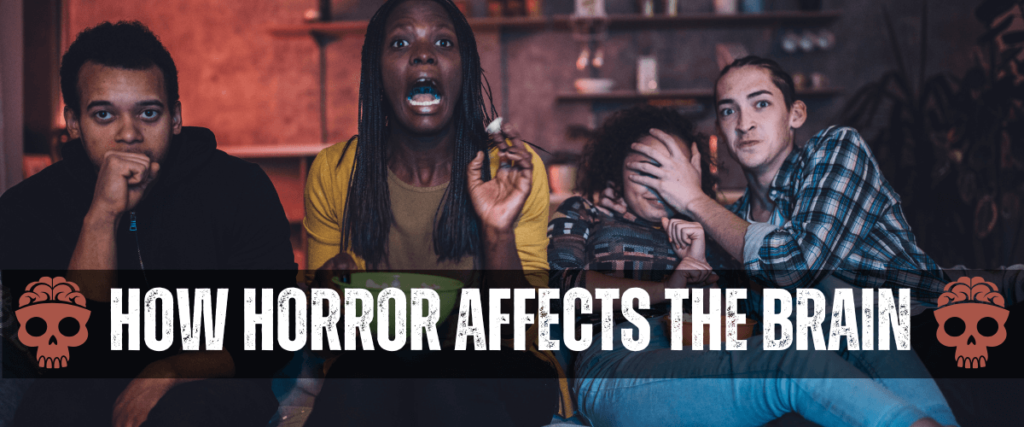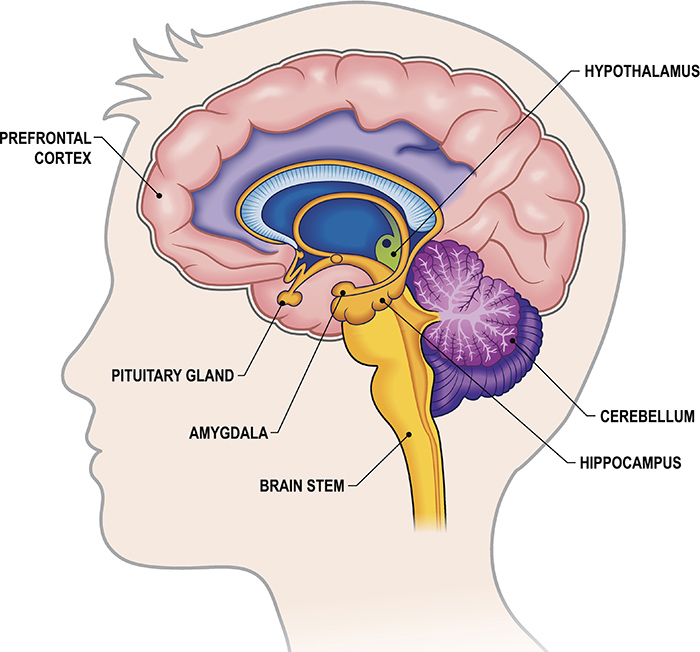Horror fiction can release a flood of brain chemicals for a scary good time.

Horror stories and movies create a strong emotional response. You’ve probably experienced this firsthand. It explains why people cringe, tense up, and sometimes peek through their fingers.
But what’s the science behind these controlled scares? How do horror stories and movies actually affect our brains?
As it turns out, there’s a fascinating chemical reaction that takes place in the brain when we read scary stories or watch frightening flicks…
- Fear Response: Horror fiction triggers the amygdala, a brain region responsible for fear processing, causing physical reactions like increased heart rate and muscle tension.
- Dopamine and Cortisol: These chemical neurotransmitters play a role in the thrill of horror, by creating a mix of fear and pleasure.
- Psychological Impact: Horror movies can either build resilience or cause anxiety, depending on an individual’s sensitivity.
- Physical Reactions: Increased heart rate, blood pressure, and adrenaline release are common responses to scary stories or movies.
Why Are Some People Drawn to Horror?
For early humans, survival depended on the ability to recognize threats and react quickly. You’ve probably heard this described as the “fight or flight” response.
Today, most of us don’t face life-or-death threats on a regular basis. But the brain’s sensitivity to fear remains active. It’s always ready to shift into self-preservation mode.
Horror movies and stories trigger these ancient responses in a controlled setting. Scary books and movies allow us to experience fear safely.
Watching and reading horror offers an adrenaline rush and thrill, similar to what people get from rollercoasters or extreme sports. But unlike a real-life danger, the fear is experienced from a safe distance.
We know the characters and situations aren’t real. So while our bodies might react as if we’re in danger, part of us knows we’re actually safe. This can be both thrilling and satisfying.
How Our Brains Respond to Fear
When we consume horror—whether it’s through movies, books, or haunted houses—our brains react in surprisingly intense ways. Here are some of the key players when it comes to fear:
1. The Amygdala
The amygdala is an almond-shaped region deep in the brain that’s essential for processing fear.

When we perceive something threatening—either real or imagined—the amygdala goes on high alert. It evaluates potential dangers and triggers a “fight-or-flight” response if needed.
All of this happens within seconds, without any conscious effort from us.
“The amygdala is central to emotion processing in the brain, and is known to contribute to fear and anxiety,” said Drew Fox, associate professor in the UC Davis Department of Psychology.
When watching a horror movie, for example, the amygdala doesn’t distinguish between a real-life threat and an on-screen monster. It only recognizes that something alarming is happening and responds accordingly.
This is why horror scenes can make our hearts race, our palms sweat, and our muscles tense up. These physical reactions can occur even though we know we are safe on the couch.
The primitive fear response is involuntary.
2. The Hippocampus
The amygdala doesn’t work alone when processing fear. Other regions get involved as well, including the hippocampus and prefrontal cortex.
The hippocampus is responsible for memory and context. During horror scenes, the hippocampus helps us remember past experiences with similar situations, like other scary movies or even real-life experiences.
The hippocampus helps link memories to emotions, amplifying the sense of dread by connecting what we’re seeing or reading to past feelings of fear.
3. The Prefrontal Cortex
This part of the brain handles rational thought and decision-making. It logically reminds us that horror movies and stories aren’t real. In doing so, it helps to keep our fear responses in check—to some extent.
But here’s where it gets interesting.
The “primitive” amygdala will sometimes override the rational prefrontal cortex. This is partly why horror can feel genuinely scary, even when we know intellectually that we’re safe.
4. Neurotransmitters and Hormones
Horror stories and movies can also affect our brain’s chemistry.
When we encounter fear, the brain releases certain chemicals that intensify our experience. The main players are dopamine and cortisol. You’ve probably heard of them before.
- Dopamine: Often referred to as the feel-good hormone, dopamine is linked to pleasure and reward. But it can also be released during frightening experiences, especially if they’re viewed as fun or safe. (Like a jump scare in a movie or haunted house.) Dopamine creates a mix of fear and pleasure, which explains why some people enjoy horror and seek it out.
- Cortisol: Known as the “stress hormone,” cortisol is released when we feel threatened. It prepares the body for a quick response by increasing blood pressure, alertness, and energy levels. When we watch horror movies, cortisol heightens our sense of danger, making us more alert and responsive to jump scares or suspenseful moments.
These and other neurochemical reactions create the intense, memorable experiences that horror fans crave.
The dopamine-cortisol combination, in particular, can deliver a heightened excitement similar to what you would get from riding a rollercoaster.
Adrenaline, Tension, and High Blood Pressure
Horror doesn’t just affect the brain. It can create intense physical reactions throughout the body, mirroring the experience of being in actual danger.
When watching a scary movie or reading a suspenseful story, our bodies respond as though we are preparing to face a real threat.
Here are some common physical effects of horror that can make it feel real:
- Heart Rate and Blood Pressure: Fear triggers a “fight-or-flight” response, raising the heart rate and blood pressure to prepare for action.
- Adrenaline Surge: Adrenaline is released, sharpening focus and redirecting blood flow to muscles, creating an “adrenaline rush” similar to extreme sports.
- Cortisol Release: The stress hormone cortisol is also released, increasing alertness and energy, which intensifies the fear response.
- Muscle Tension: Muscles may tense up instinctively, especially in the neck and shoulders, as the body braces for potential action.
- Startle Response: Sudden movements or loud noises in horror cause a quick, involuntary reaction, like flinching or gasping, adding to immersion.
Long-Term Effects of Repeated Exposure
Most of the physical reactions to horror fiction are short-lived. But repeated exposure can cause longer-lasting effects in some people.
People who read scary stories or watch horror movies on a regular basis can become desensitized to the stimuli. Their heart rate and cortisol spikes might decrease over time.
Imagine two people sitting together in a movie theater. One is a horror movie buff who regularly watches scary movies. The other typically avoids frightening films and hasn’t seen one in years.
These two moviegoers might have very different emotional and physical reactions:
- The horror fan experiences only a slight increase in heart rate and adrenaline, because their body is used to these reactions. They enjoy the thrill and remain actively engaged with the plot, looking for clues and anticipating scares.
- The non-horror-fan experiences a significant increase in heart rate, sweating, and muscle tension. During intense scenes, they feel fear, anxiety, and even physical discomfort. They struggle to focus on the plot, as they are preoccupied with their own emotional state.
This desensitization happens because the brain and body become used to certain patterns and can better distinguish real threats from fictional ones.
What do you think? How do you react to horror and why do you come back to it? Feel free to drop a comment below!
